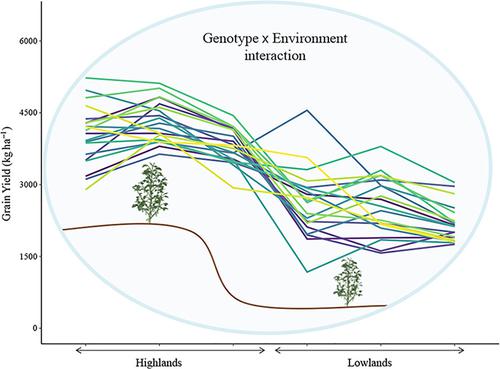当前位置:
X-MOL 学术
›
Ann. Appl. Biol.
›
论文详情
Our official English website, www.x-mol.net, welcomes your feedback! (Note: you will need to create a separate account there.)
Soybean grain yield in highland and lowland cultivation systems: A genotype by environment interaction approach
Annals of Applied Biology ( IF 2.6 ) Pub Date : 2021-06-09 , DOI: 10.1111/aab.12709 Rafael Rodrigues Souza 1 , Marcos Toebe 1 , Volmir Sergio Marchioro 1 , Alberto Cargnelutti Filho 2 , Anderson Chuquel Mello 1 , Guilherme Liberalesso Manfio 1 , Francis Júnior Soldateli 2 , Franciéle Santos Soares 3 , Vinícius Martins 1 , Diéssica Leticia Junges 1
Annals of Applied Biology ( IF 2.6 ) Pub Date : 2021-06-09 , DOI: 10.1111/aab.12709 Rafael Rodrigues Souza 1 , Marcos Toebe 1 , Volmir Sergio Marchioro 1 , Alberto Cargnelutti Filho 2 , Anderson Chuquel Mello 1 , Guilherme Liberalesso Manfio 1 , Francis Júnior Soldateli 2 , Franciéle Santos Soares 3 , Vinícius Martins 1 , Diéssica Leticia Junges 1
Affiliation

|
Genotype x environment interaction (GEI) causes constant interference in soybean [Glycine max (L.) Merr.] grain yield. This complexity tends to increase when comparing highland and lowland cultivation systems, and there has been little referenced work for these in the situation of subtropical conditions. Hence, the aims of this study were to verify the effects of genotypes, environments and GEI for soybean grain yield in highland and lowland areas with subtropical climate and to compare the adaptability and stability methodologies. The trials were carried out in two locations of the state of Rio Grande do Sul, Brazil, with 20 soybean cultivars on three sowing dates for each location. The experiments were conducted in a randomised block design with three replications. Given the observed magnitude of the GEI, its simple and complex parts were quantified for further analysis of adaptability and stability, using the Additive Main Effect and Multiplicative Interaction (AMMI), Genotype plus Genotype–Environment interaction (GGE) and Best Linear Unbiased Prediction (BLUP) modelling approaches, followed by the verification of similarity between the methodologies via Spearman's correlation coefficient. The complex part of the GEI represented 82.11% of the total variation associated with the GEI, whereas the simple part accounted for 17.89% of that variation. The second sowing date, in both locations, was the one that presented the best rankings according to the models used, and also, cases of specific genotype adaptability were identified in each environment. The highest yield averages were obtained in the highlands. The GGE and BLUP techniques presented genotypic ranking concordance.
中文翻译:

高地和低地栽培系统中的大豆籽粒产量:环境相互作用方法的基因型
基因型 x 环境相互作用 (GEI) 对大豆造成持续干扰 [ Glycine max(L.) Merr.] 粮食产量。在比较高地和低地栽培系统时,这种复杂性往往会增加,而在亚热带条件下,这方面的参考工作很少。因此,本研究的目的是验证基因型、环境和GEI对亚热带气候高地和低地地区大豆产量的影响,并比较适应性和稳定性方法。试验在巴西南里奥格兰德州的两个地点进行,每个地点的三个播种日期有 20 个大豆品种。实验以随机区组设计进行,重复三次。鉴于观测到的 GEI 的大小,对其简单和复杂的部分进行了量化,以进一步分析适应性和稳定性,使用加性主效应和乘性相互作用 (AMMI)、基因型加基因型-环境相互作用 (GGE) 和最佳线性无偏预测 (BLUP) 建模方法,然后通过 Spearman 相关系数验证方法之间的相似性。GEI 的复杂部分占与 GEI 相关的总变异的 82.11%,而简单部分占该变异的 17.89%。在这两个地点,第二个播种日期是根据所使用的模型呈现最佳排名的日期,并且还确定了每个环境中特定基因型适应性的情况。在高地获得了最高的平均产量。GGE 和 BLUP 技术呈现基因型排序一致性。基因型加基因型-环境相互作用 (GGE) 和最佳线性无偏预测 (BLUP) 建模方法,然后通过 Spearman 相关系数验证方法之间的相似性。GEI 的复杂部分占与 GEI 相关的总变异的 82.11%,而简单部分占该变异的 17.89%。在这两个地点,第二个播种日期是根据所使用的模型呈现最佳排名的日期,并且还确定了每个环境中特定基因型适应性的情况。在高地获得了最高的平均产量。GGE 和 BLUP 技术呈现基因型排序一致性。基因型加基因型-环境相互作用 (GGE) 和最佳线性无偏预测 (BLUP) 建模方法,然后通过 Spearman 相关系数验证方法之间的相似性。GEI 的复杂部分占与 GEI 相关的总变异的 82.11%,而简单部分占该变异的 17.89%。在这两个地点,第二个播种日期是根据所使用的模型呈现最佳排名的日期,并且还确定了每个环境中特定基因型适应性的情况。在高地获得了最高的平均产量。GGE 和 BLUP 技术呈现了基因型排序的一致性。然后通过 Spearman 相关系数验证方法之间的相似性。GEI 的复杂部分占与 GEI 相关的总变异的 82.11%,而简单部分占该变异的 17.89%。在这两个地点,第二个播种日期是根据所使用的模型呈现最佳排名的日期,并且还确定了每个环境中特定基因型适应性的情况。在高地获得了最高的平均产量。GGE 和 BLUP 技术呈现了基因型排序的一致性。然后通过 Spearman 相关系数验证方法之间的相似性。GEI 的复杂部分占与 GEI 相关的总变异的 82.11%,而简单部分占该变异的 17.89%。在这两个地点,第二个播种日期是根据所使用的模型呈现最佳排名的日期,并且还确定了每个环境中特定基因型适应性的情况。在高地获得了最高的平均产量。GGE 和 BLUP 技术呈现基因型排序一致性。在这两个地点,根据所使用的模型呈现最佳排名的地点,并且在每个环境中都确定了特定基因型适应性的案例。在高地获得了最高的平均产量。GGE 和 BLUP 技术呈现基因型排序一致性。在这两个地点,根据所使用的模型呈现最佳排名的地点,并且在每个环境中都确定了特定基因型适应性的案例。在高地获得了最高的平均产量。GGE 和 BLUP 技术呈现基因型排序一致性。
更新日期:2021-06-09
中文翻译:

高地和低地栽培系统中的大豆籽粒产量:环境相互作用方法的基因型
基因型 x 环境相互作用 (GEI) 对大豆造成持续干扰 [ Glycine max(L.) Merr.] 粮食产量。在比较高地和低地栽培系统时,这种复杂性往往会增加,而在亚热带条件下,这方面的参考工作很少。因此,本研究的目的是验证基因型、环境和GEI对亚热带气候高地和低地地区大豆产量的影响,并比较适应性和稳定性方法。试验在巴西南里奥格兰德州的两个地点进行,每个地点的三个播种日期有 20 个大豆品种。实验以随机区组设计进行,重复三次。鉴于观测到的 GEI 的大小,对其简单和复杂的部分进行了量化,以进一步分析适应性和稳定性,使用加性主效应和乘性相互作用 (AMMI)、基因型加基因型-环境相互作用 (GGE) 和最佳线性无偏预测 (BLUP) 建模方法,然后通过 Spearman 相关系数验证方法之间的相似性。GEI 的复杂部分占与 GEI 相关的总变异的 82.11%,而简单部分占该变异的 17.89%。在这两个地点,第二个播种日期是根据所使用的模型呈现最佳排名的日期,并且还确定了每个环境中特定基因型适应性的情况。在高地获得了最高的平均产量。GGE 和 BLUP 技术呈现基因型排序一致性。基因型加基因型-环境相互作用 (GGE) 和最佳线性无偏预测 (BLUP) 建模方法,然后通过 Spearman 相关系数验证方法之间的相似性。GEI 的复杂部分占与 GEI 相关的总变异的 82.11%,而简单部分占该变异的 17.89%。在这两个地点,第二个播种日期是根据所使用的模型呈现最佳排名的日期,并且还确定了每个环境中特定基因型适应性的情况。在高地获得了最高的平均产量。GGE 和 BLUP 技术呈现基因型排序一致性。基因型加基因型-环境相互作用 (GGE) 和最佳线性无偏预测 (BLUP) 建模方法,然后通过 Spearman 相关系数验证方法之间的相似性。GEI 的复杂部分占与 GEI 相关的总变异的 82.11%,而简单部分占该变异的 17.89%。在这两个地点,第二个播种日期是根据所使用的模型呈现最佳排名的日期,并且还确定了每个环境中特定基因型适应性的情况。在高地获得了最高的平均产量。GGE 和 BLUP 技术呈现了基因型排序的一致性。然后通过 Spearman 相关系数验证方法之间的相似性。GEI 的复杂部分占与 GEI 相关的总变异的 82.11%,而简单部分占该变异的 17.89%。在这两个地点,第二个播种日期是根据所使用的模型呈现最佳排名的日期,并且还确定了每个环境中特定基因型适应性的情况。在高地获得了最高的平均产量。GGE 和 BLUP 技术呈现了基因型排序的一致性。然后通过 Spearman 相关系数验证方法之间的相似性。GEI 的复杂部分占与 GEI 相关的总变异的 82.11%,而简单部分占该变异的 17.89%。在这两个地点,第二个播种日期是根据所使用的模型呈现最佳排名的日期,并且还确定了每个环境中特定基因型适应性的情况。在高地获得了最高的平均产量。GGE 和 BLUP 技术呈现基因型排序一致性。在这两个地点,根据所使用的模型呈现最佳排名的地点,并且在每个环境中都确定了特定基因型适应性的案例。在高地获得了最高的平均产量。GGE 和 BLUP 技术呈现基因型排序一致性。在这两个地点,根据所使用的模型呈现最佳排名的地点,并且在每个环境中都确定了特定基因型适应性的案例。在高地获得了最高的平均产量。GGE 和 BLUP 技术呈现基因型排序一致性。



























 京公网安备 11010802027423号
京公网安备 11010802027423号